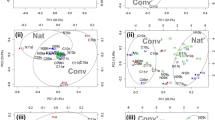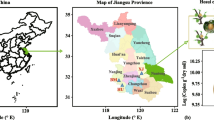Abstract
A number of management practices, such as soil fumigation and flooding, have been employed in efforts to control diseases and weeds in the cultivation of ornamental flower bulbs. However, such treatments may affect the suppression of Pythium root rot, a serious problem in ornamental bulb culture. To gain insight into the nature of Pythium suppression in such soils, we sought to describe the changes that these soil treatments induce in the microbial community in order to determine if particular microbial components of the system could be associated with suppression. Four polymerase chain reaction-denaturing gradient gel electrophoresis (PCR-DGGE) strategies, two targeting bacteria and two targeting fungi, were used to compare the soil-borne microbial communities of untreated, fumigated, flooded and sterilized, compost-amended soils; the dominant community members were tentatively identified by sequencing of DGGE bands. For all profiling strategies, the compost treatment of sterilized soil appeared to have the most profound effect on the dominant microbial populations in the soil. In general, different primer sets that targeted the same microbial groups, bacteria or fungi, appeared to detect the same microbial taxa, although certain sequence types were detected in only a single profiling strategy. DNA-based microbial community profiles alone were poor predictors of Pythium suppression, as the dominant microbial populations remained mostly intact, even after rigorous soil treatments such as fumigation and flooding. The restoration of suppressive activity against Pythium in compost-amended soil was associated with a different microbial community than observed in untreated, suppressive soils. Thus, although previous studies have shown the suppression of Pythium to be mediated by biological agents, effects of different microbial communities can lead to this suppression.



Similar content being viewed by others
References
Altschul SF, Madden TL, Schaffer AA, Zhang J, Zhang Z, Miller W, Lipman DJ (1997) Gapped BLAST and PSI-BLAST: a new generation of protein database search programs. Nucl Acids Res 25:3389–3402
Becker JO, Cook RJ (1988) Role of siderophores in suppression of Pythium speceis and production of increased-growth response of wheat by fluorescent pseudomonads. Phytopathology 78:778–782
Borneman J (1999) Culture-independent identification of microorganisms that respond to specified stimuli. Appl Environ Microbiol 65:3398–3400
Bossio DA, Scow KM (1995) Impact of carbon and flooding on the metabolic diversity of microbial communities in soils. Appl Environ Microbiol 61:4043–4050
Brüggemann J, Stephen JR, Chang Y-J, Macnaughton SJ, Kowalchuk GA, Kline E, White DC (2000) Competitive PCR-DGGE analysis of bacterial mixtures: an internal standard and an appraisal of template enumeration accuracy. J Microbiol Meth 40:111–123
Chang YJ, Stephen JR, Richter AP, Venosa AD, Brüggemann J, Macnaughton SJ, Kowalchuk G, Haines JR, White DC (2000) Phylogenetic analysis of aerobic freshwater and marine enrichment cultures efficient in hydrocarbon degradation: effect of profiling method. J Microbiol Meth 40:19–31
Chen W, Hoitink HAJ, Schmitthenner AF, Tuonvinen OH (1988) The role of microbial activity in suppression of damping-off caused by Pythium ultimum. Phytopathology 78:314–322
Di Pietro A, Gut-Rella M, Pachlatko JP, Schwinn FJ (1992) Role of antibiotics produced by Chaetomium globosum in biocontrol of Pythium ultimum, a causal agent of damping-off. Phytopathology 82:131–135
Duineveld BM, Kowalchuk GA, Keizer A, Van Elsas JD, Van Veen JA (2001) Analysis of the bacterial communities in the rhizosphere of chrysanthemum via denaturing gradient gel electrophoresis of PCR amplified 16S ribosomal RNA and DNA fragments. Appl Environ Microbiol 67:172–178
Elad Y, Chet I (1987) Possible control of competition for nutrients in biocontrol of Pythium damping-off by bacteria. Phytopathology 77:190–195
Felske A, Engelen B, Nübel U, Backhaus H (1996) Direct ribosome isolation from soil to extract bacterial rRNA for community analysis. Appl Environ Microbiol 62:4162–4167
Ferris MJ, Muyzer G, Ward DJ (1996) Denaturing gradient gel electrophoresis profiles of 16S rRNA-defined populations inhabiting a hot spring microbial mat community. Appl Environ Microbiol 62:340–346
Heuer H, Krsek M, Baker P, Smalla K, Wellington EMH (1997) Analysis of actinomycete communities by specific amplification of genes encoding 16S rRNA and gel-electrophoretic separation in denaturing gradients. Appl Environ Microbiol 63: 3233–3241
Ho WC, Ko WH (1986) Microbiostasis by nutrient deficiency shown in natural and synthetic soils. J Gen Microbiol 132:2807–2815
Koster ATHJ, De Rooij M (1980) New possibilities for chemical control of root rot (Pythium spp.) in cultivation of bulbs and bulb flowers. Acta. Horticulturae 109:375–380
Kowalchuk GA (1999a) Fungal Community Analysis using Denaturing Gradient Gel Electrophoresis (DGGE). In: Akkermans ADL, Van Elsas JD, De Bruijn FJ (eds) Molecular microbial ecology manual. Kluwer, Dordrecht pp 3.4.6.1–16
Kowalchuk GA (1999b) New perspectives towards analising fungal communities in terrestrial ecosystems. Curr Opin Biotech 10:247–251
Kowalchuk GA, Gerards S, Woldendorp JW (1997a) Detection and characterization of fungal infections of Ammophila arenaria (marram grass) roots by denaturing gradient gel electrophoresis (DGGE) of specifically amplified 18S-rDNA. Appl Environ Microbiol 63:3858–3865
Kowalchuk GA, Stephen LR, De Boer W, Prosser JI, Embley TM, Woldendorp JW (1997b) Analysis of β-proteobacteria ammonia-oxidizing bacteria in coastal sand dunes using denaturing gradient gel electrophoresis and sequencing of PCR amplified 16S rDNA fragments. Appl Environ Microbiol 63:1489–1497
Kowalchuk GA, Naoumenko ZS, Derikx PJL, Felske A, Stephen JR, Arkhipchenko IA (1999) Molecular analysis of ammonia-oxidizing bacteria of the β subdivision of the class Proteobacteria in compost and composted materials. Appl Environ Microbiol 65:396–403
Laanbroek HJ (1990) Bacterial cycling of minerals that affect plant growth in waterlogged soils: a review. Aquat Bot 38:109–125
Maidak BL, Cole JR, Lilburn TG, Parker CT, Saxman PR, Farris RJ, Garrity GM, Olsen GJ, Schmidt TM, Tiedje JM (2001) The RDP-II (Ribosomal Database Project). Nucl Acids Res 29:173–174
Martin RR, James D, Levesque CA (2000) Impacts of molecular diagnostic technologies on plant disease management. Annu Rev Phytopathol 38:207–232
May LA, Smiley B, Schmidt MG (2001) Comparative denaturing gradient gel electrophoresis analysis of fungal communities associated with whole plant corn silage. Can J Microbiol 47:829–841
Muller PJ (1987) Control of soil-borne diseases, nematodes and weeds in ornamental bulb cultivation by flooding. Acta Bot Ned 36:111
Muyzer G, Smalla K (1998) Application of denaturing gradient gel electrophoresis (DGGE) and temperature gradient gel electrophoresis (TGGE) in microbial ecology. Antonie Van Leeuwenhoek 73:127–141
Muyzer G, De Waal EC, Uitterlinden AC (1993) Profiling of complex microbial populations by denaturing gradient gel electrophoresis analysis of polymerase chain reaction-amplified genes for 16S rRNA. Appl Environ Microbiol 59:695–700
Ponnamperuma FN (1984) Effects of flooding on soils. In: Kozlowski TT (ed) Flooding and plant growth. Academic Press, New York, pp 9–45
Schabereiter-Gurtner C, Piñar G, Lubitz W, Rölleke S (2001) Analysis of fungal communities on historical church window glass by denaturing gradient gel electrophoresis and phylogenetic 18S rDNA sequence analysis. J Microbiol Meth 47:345–354
Smit E, Leeflang P, Glandorf B, Van Elsas JD, Wernars K (1999) Analysis of fungal diversity in the wheat rhizosphere by sequencing of cloned PCR-amplified genes encoding 18S rRNA and temperature gradient gel electrophoresis. Appl Environ Microbiol 65:2614–2621
Speksnijder AGCL, Kowalchuk GA, De Jong S, Kline E, Stephen JR, Laanbroek HJ (2001) Micro-variation artifacts introduced by PCR and cloning of closely related 16S rDNA sequences. Appl Environ Microbiol 67:469–472
Stephen JR, Kowalchuk GA (2002) Ribotyping methods for assessment of in situ microbial community structure. In: Bitton G (ed) Encyclopedia of environmental microbiology, vol 5. Wiley, New York, pp 2728–2741
Teske A, Wawer C, Muyzer G, Ramsing NB (1996) Distribution of sulfate-reducing bacteria in a stratified fjord (Mariagerfjord, Denmark) as evaluated by most-probable number counts and denaturing gradient gel electrophoresis of PCR-amplified ribosomal DNA fragments. Appl Environ Microbiol 62:1405–1415
Tuitert G, Szczech M, Bollen GJ (1998) Suppression of Rhizoctonia solani in potting mixtures amended with compost made from organic household waste. Phytopathology 88:764–773
Vainio EJ, Hantula J (2000) Direct analysis of wood-inhabiting fungi using denaturing gradient gel electrophoresis of amplified ribosomal DNA. Mycol Res 104:927–936
Van Os GJ, Van Ginkel JH (2001) Suppression of Pythium root rot in bulbous iris in relation to biomass and activity of the soil microflora. Soil Biol Biochem 33:1447–1454
Van Os GJ, Van Gulik WJM, De Boer WJ (1998) Disease development of Pythium root rot in bulbous iris and crocus. Ann Appl Biol 132:227–238
Van Os GJ, Wijnker JPM, Van Gulik WJM (1999) Effects of soil fumigation and flooding on suppression of Pythium root rot in ornamental bulb culture. Eur J Plant Path 105:791–800
Van Zaayen A, Asjes CJ, Bregman D, Koster AThJ, Muller PJ, Van Der Valk GGM, Vos I, Bogers RJ (1986) Control of soil-borne diseases, nematodes and weeds in ornamental bulb cultivation by flooding. Hortiscience 21:162
Watanabe K, Kodama Y, Harayama S (2001) Design and evaluation of PCR primers to amplify bacterial 16S ribosomal DNA fragments used for community fingerprinting. J Microbiol Meth 44:253–262
Weststeijn EA (1990) Fluorescent Pseudomonas isolate E11.3 as biocontrol agent for Pythium root-root in tulips. Neth J Plant Pathol 96:261–272
Weststeijn G, De Rooij M (1974) Control of soil-borne fungi and nematodes parasitic to ornamental bulbous crops in The Netherlands with special reference to soil disinfestation. Agric Environ 1:237–242
Whipps JM, Lumsden RD (1991) Biological control of Pythium species. Biocontrol Sci Tech 1:75–90
White TJ, Bruns T, Lee S, Taylor J (1990) Amplification and direct sequencing of fungal ribosomal RNA genes for phylogenetics. In: Innins MAD, gelfand H, Sninsky JJ, White TJ (eds) PCR protocols. Academic Press, San Diego, Calif., pp 315–322
Acknowledgements
The authors thank Wietse de Boer for critical reading of the manuscript and Jeroen Wijnker for practical assistance. This study was partly supported by the Urgency Program for Research on Diseases and Breeding of Flower Bulbs. This manuscript represents publication no. 3,051 of the NIOO-KNAW Netherlands Institute of Ecology.
Author information
Authors and Affiliations
Corresponding author
Rights and permissions
About this article
Cite this article
Kowalchuk, G.A., van Os, G.J., van Aartrijk, J. et al. Microbial community responses to disease management soil treatments used in flower bulb cultivation. Biol Fertil Soils 37, 55–63 (2003). https://doi.org/10.1007/s00374-002-0561-6
Received:
Accepted:
Published:
Issue Date:
DOI: https://doi.org/10.1007/s00374-002-0561-6




